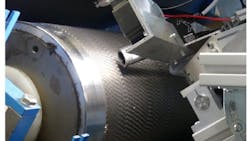Research Team Develops Inspection System for Textile Industry
Researchers from the Faserinstitut Bremen Research Institute (Bremen, Germany) and Chemnitz University of Technology (Chemnitz, Germany) have developed a vision inspection/analysis process for card clothing.
Holger Fischer, senior researcher at the Faserinstitut, led the project.
Card clothing is sturdy fabric, usually with a leather or rubber fillet imbedded with wire teeth. Card clothing is placed to cover the rollers/cylinders of a carding machine. The material to be “carded” is passed between differentially moving cylinders covered with card clothing. The purpose of the carding process is to disentangle, clean and intermix fibers to produce a continuous web suitable for subsequent processing.
However, this continuous exposure to abrasive raw fibers results in wear and damage to the wire teeth, which, in turn, leads to a reduction in quality. Fischer explains that, in nonwovens production when processing high-performance fibers—carbon, glass, aramid, for example—card clothing is subject to a significantly higher degree of wear than for other types of fibers. Currently, non-woven production lines must routinely replace all card clothing on all card machines according to prescribed maintenance schedules, regardless of the level of wear. This is done so that production can continue with minimal unexpected delay or interruption. But this is also an expensive process, from labor to manufacturing downtime and wasted raw materials.
“This leads to unnecessarily frequent maintenance intervals,” Fischer explains. “So, the aim of the project was to prevent avoidable clothing changes by developing an online wear measurement system and to take a step towards industry 4.0 in terms of maintenance prediction.”
Related: Fraunhofer Institute Researchers Develop AI-assisted Inspection System
Building a Machine Vision Inspection System
Fischer and his team put together their inspection system using an SVS-Vistek (Gilching, Germany) exo541MGE 10.3 MPixel CMOS GigE camera and Opto Engineering (Mantova, ItalySA) MC3-03X lens. The camera and lens were mounted in an IP67 rated camera enclosure, which was then mounted on an aluminum rack over a production line. Team members could then manually maneuver the camera into an appropriate position for scanning card cylinders.
The camera was connected to a laptop computer, located on the manufacturing floor, via PoE cable.
The camera, positioned at a 45° angle at 2 mm above the card clothing teeth, was set up to scan an area of about 25 x 25 mm at a time, at 4504 x 4504 resolution. The team also attached a Justbright JBBL-0506-WT LED illumination unit from MBJ Imaging GmbH (Ahrensburg, Germany) to the camera holder.
The team tested the system on a plant line at Sächsisches Textil Forschungs Institut (Chemnitz, Germany) as well as on production lines of three partner companies, Fischer says.
During the inspection process, performed during regular maintenance intervals for the manufacturing lines when maintenance doors on the machines are open, Fischer and his team used software to move the camera along the track automatically, allowing it to capture images of each carding cylinder. The image data was transmitted, stored, and analyzed on the laptop using AI software developed by Fischer’s team.
The system, of course, would be operated by employees of whatever company is using the system, if it is further developed for industrial use, Fischer notes.
RGB Camera System Detects Card Clothing Parts
The system worked as designed, but with caveats, Fischer says.
“For future industrial use, further development of the system will be necessary,” Fischer says.
The camera system can easily detect the card clothing teeth from back, front, and working angles, as well as detect damaged edges and tips, and the images data does enable a reproducible analysis.
But several challenges remain. First, because each card machine, and card cylinder, is different, each inspection and analysis process must be tailored individually, at the machine itself, based on such factors as cylinder size, diameter, and tooth positioning, as well as the type of card clothing fiber being used.
“Furthermore, not every cylinder of each roller-card is visible, or reachable, for the camera system,” Fischer says. “This will require either adapted versions of the camera mount, or it may require constructive changes at the machine.”
Finally, the AI software will need more development and refinement to take the system beyond the proof-of-concept mode, Fischer says. Such improvements include developing a database of cylinder geometries and card clothing types to be observed, data regarding typical wear patterns and limits of clothing usability, and data for optimal camera positioning for each occurring combination of cylinder geometry and clothing used on it.
Related: At The Edge: Vision AI Software Improves Quality Inspections
About the Author
Jim Tatum
Senior Editor
VSD Senior Editor Jim Tatum has more than 25 years experience in print and digital journalism, covering business/industry/economic development issues, regional and local government/regulatory issues, and more. In 2019, he transitioned from newspapers to business media full time, joining VSD in 2023.


